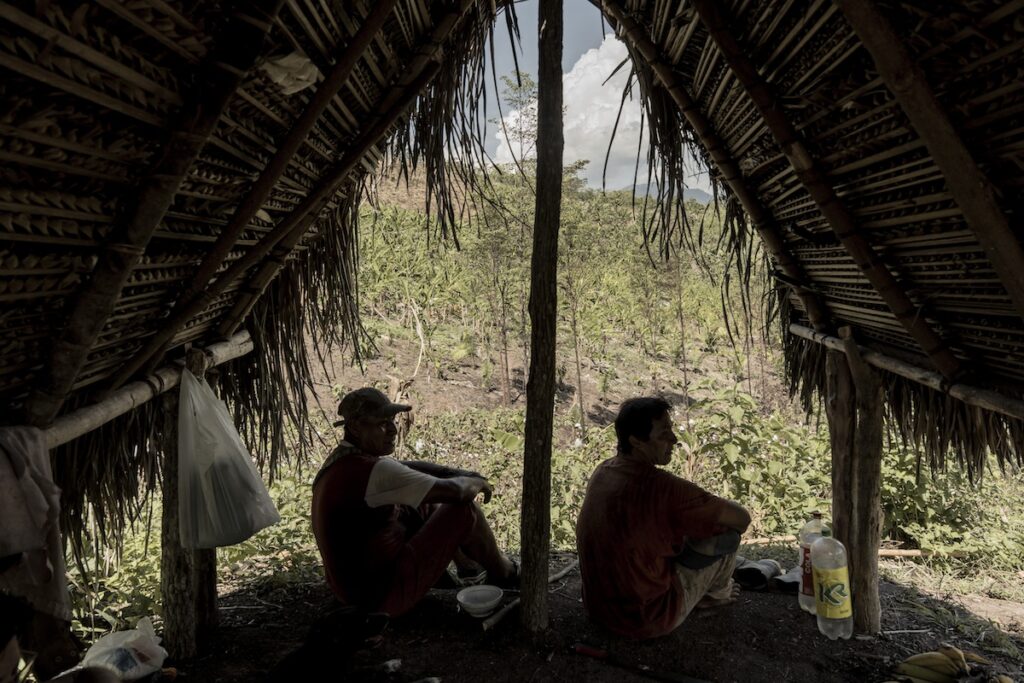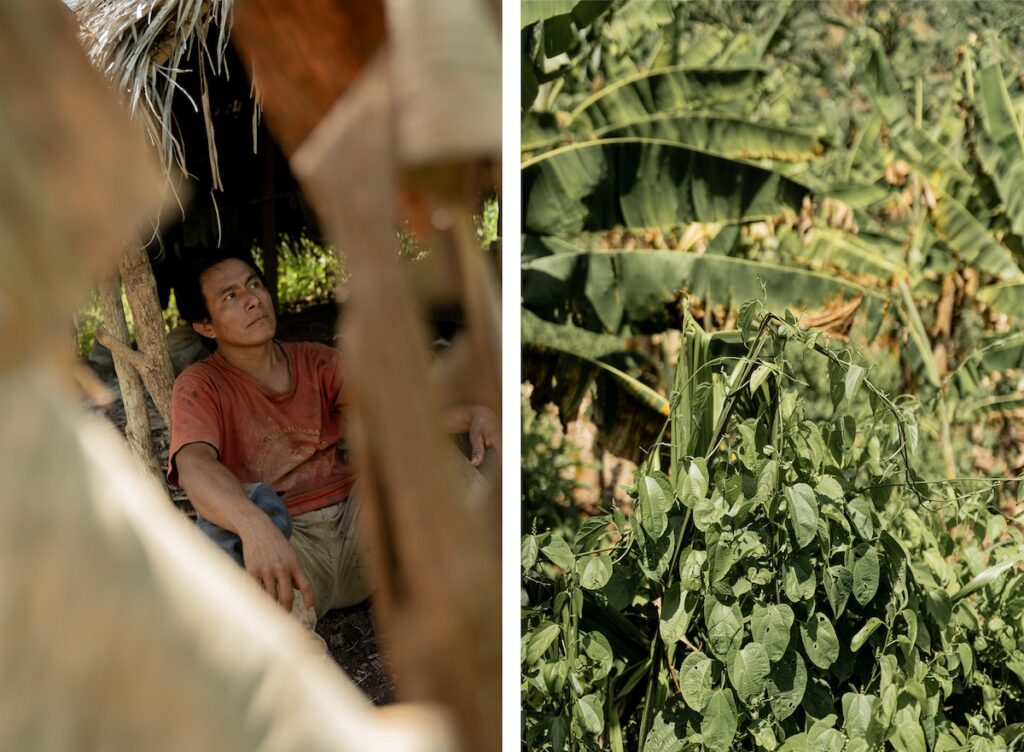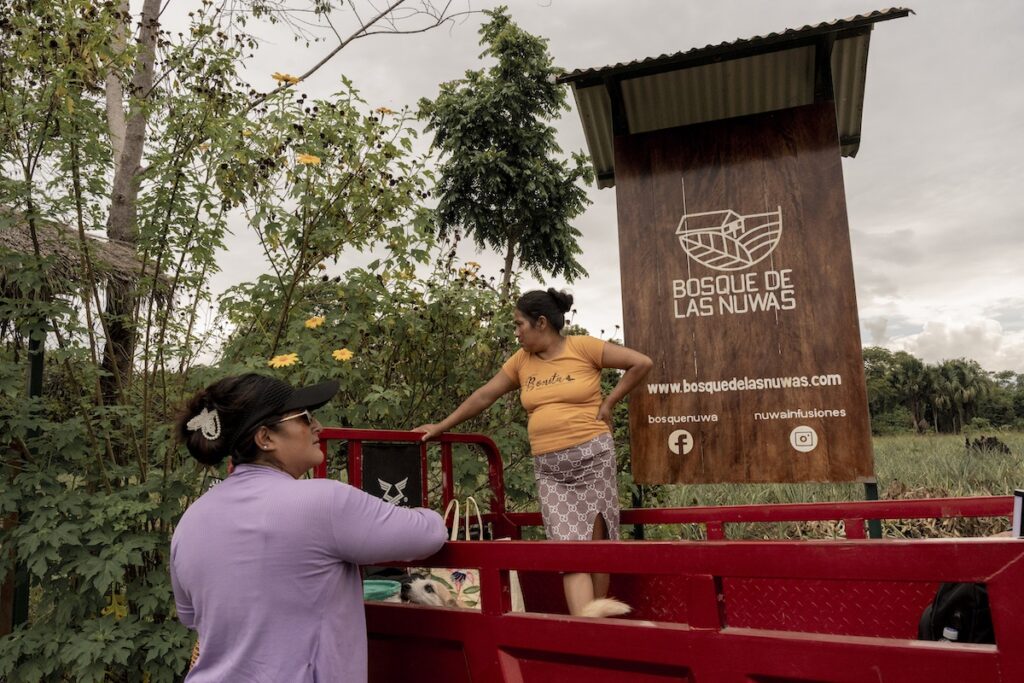In the San Martín region, in Peru’s northern jungle, when the sky splits in two and the rain falls with the force of a river, Alfredo Sangama Sinarahua takes shelter in a hut he built with his own hands. The roof is made of braided leaves, and the dirt floor is speckled with hard brown fragments: the shells of sacha inchi, the Inca peanut.
Alfredo, a 39-year-old Kichwa farmer, strikes the seeds with a stick as he waits for the rain to let up. It takes strength to open them. Inside, the pods hide a golden oil that, in some European laboratory, is transformed into an anti-aging ointment or a vegan supplement.
Alfredo planted sacha inchi on a hillside of no more than a thousand square meters, near the community of Solo del Río Mayo. The plants climb over other plants and tangle together as they reach for the sun. A few years ago, he worked in restaurants in Tarapoto, but he returned to the countryside because varicose veins forced him to leave the kitchen. “I live more peacefully,” he says. “I only work until midday.”
Fifteen years ago, his uncle Misael Salas Amasifuen chaired the sacha inchi producers’ committee. “We were twenty members; now none of us are still at it,” he recalls, lighting a cigarette. In 2010, the crop spread throughout the jungle: NGOs, technicians, and promises of prosperity. Then came silence.
Prices collapsed, the committees dissolved, and the shelling machine once donated by the company Roda Selva was left abandoned on the riverbank. Only a few, like Alfredo, keep the habit of cracking the seeds when it rains: a way to pass the time.

Sacha inchi – Plukenetia volubilis – has been growing in the Amazon for more than three thousand years. Its seeds yield flour and oil rich in omega-3, 6, and 9 – more than salmon or walnuts. For centuries it has been both medicine and food: women have used it as a hair cream, and elders have taken it to strengthen the heart.I n the 1980s, a scientific study revealed its nutritional properties.
Twenty years later, the first exports to France turned it into a raw material for the cosmetics industry. In 2004, sacha inchi oil could enter Europe as a beauty product but not as food – because the “Novel Food” regulation prohibited food products that had not been used for human consumption within the European Union before 1997, even if they had been consumed by other civilizations for centuries.
This changed in 2013, when its use as food was approved, and in a short time demand from the food industry surpassed that of cosmetics. As mentioned, sacha inchi surpasses salmon in omegas and, being a plant-based source, is praised for being healthy and natural. Thus, in a short time, interest in the seed caught the attention of some European companies, and its long ancestral history changed hands.

In 2005, the French company Greentech applied for a patent based on the cosmetic properties of sacha inchi as a skin ointment – and obtained it. At the same time, the multinational Cognis, headquartered in Germany, filed another patent through the PCT system, which allows an invention to be protected in numerous countries through a single international application.
In 2006, from Peru, the National Commission Against Biopiracy appealed before the National Institute of Industrial Property (INPI) in Paris and before the European Patent Office. It argued that the cosmetic use Greentech sought to patent was the traditional use of the Chayahuita, Campa, Bora, and Huitoto Indigenous communities of the Amazon and therefore was not a novelty, but traditional knowledge. The Commission was fulfilling its mandate: to prevent ancestral collective knowledge from being exclusively exploited by private actors without sharing the benefits.
From that point on there were negotiations, lawyers, reports, and interpretations of the law and the world of patents that ended with the companies withdrawing: neither Greentech nor Cognis succeeded in patenting the seed or its ancestral use, though they did manage to turn it into a commodity elsewhere. Challenging a patent does not prevent commercialization; it only makes it less visible.
Before giving up, Greentech offered an alternative: for the patent to be transferred to Agroindustrias Amazónicas, a Peruvian company in which it then owned approximately 20% of the shares. The deal did not go through, but the connection was sealed. Currently, the company's stake has been reduced to less than 4%, although it remains the main customer for the purchase of sacha inchi oil for the cosmetics industry.
The knowledge of the women of Shampuyacu
Omar Ríos Rojas, director of Agroindustrias Amazónicas, stated that between 2019 and 2020, the company's former manager, José Anaya, ceded the company's land to Xiadong Ji Wu, a Chinese businessman investigated by the Peruvian Public Ministry for alleged links to an organization dedicated to illegal timber trafficking. The agreement allowed for the cultivation of sacha inchi on 42 hectares of the company's land, and all the production was processed in the factory and sold to China as "conventional oil," says Ríos Rojas.
Meanwhile, in the Forest of the Nuwas, three hours from the Tarapoto airport, heading north along the Fernando Belaúnde Terry highway, a group of Awajún women protects another form of knowledge. They are the guardians of a fragment of primary jungle, surrounded by rice fields. There, among trees that prevent the light from entering abruptly, medicinal plants grow: piri piri, ajo sacha, herbs for fever and for blurred vision.Ludia Sejekam plucks a leaf of ajo sacha, pierces it, and places it over her eyes like a mask. "It helps you see better," she assures. She learned it from her mother, and she from hers. In the Awajún community, knowledge is inherited orally and cared for as part of the body.

For a time, the women of Shampuyacu shared this knowledge with the tourists who came to the forest. They showed them the plants, explained their uses, and the visitors would ask for "a little plant" to take to their countries. "They take it, plant it, and profit," says Flor de María Samajain. "And for us, nothing."
In legal discourse, biopiracy sounds technical. On the ground, it is a modern form of expropriation. The term refers to the use of intellectual property laws to monopolize genetic resources and traditional knowledge. As philosopher Nancy Fraser explains, capitalism is sustained by both exploitation and expropriation: it extracts resources from non-market spheres – nature, ancestral knowledge, community life – to create its own profit.
Indigenous peoples do not have a concept of private property that resembles that of a patent. "Our knowledge has been violated for a long time," says Wilfredo Tmash, president of the Awajún Alto Mayo Regional Indigenous Federation.
In legal discourse, biopiracy sounds technical. On the ground, it is a modern form of expropriation
Peru, the country of origin of sacha inchi, is also one of the countries that has documented the most cases and is an example in the fight against biopiracy. Since the 1992 Rio Summit, when the Convention on Biological Diversity was adopted, the country began to develop national legislation to protect collective knowledge. In 2004, it created the National Commission Against Biopiracy, which to date has identified 558 cases of suspected foreign appropriation of Peruvian natural resources.

The commission monitors 43 patent offices and analyzes more than 15,000 documents a year. Thanks to its interventions, it has managed to block 173 improper registrations. But the work is uneven. "If a patent has already been granted, it's a complicated process and also a very expensive one," acknowledges its chairman, Andrés Valladolid. "To litigate the case of the maca patent granted in the United States, a budget of one million soles (more than $297.000) was required."
The “oil of the future” triumphs in Asia
The irony is that, while Peru fights to defend the origin of its seed, sacha inchi is being legally cultivated on other continents. It has been grown in China since 2006, in the humid forests of Xishuangbanna, Yunnan province. There, where rubber once grew, Chinese farmers now plant the Amazonian plant as the "oil of the future."
The product is sold on Taobao, the largest e-commerce platform in the country, under brands like Yin Qi, in packaging that features a brown star on a green background, evoking a distant jungle that is available at the click of a button.
In South Korea, the birthplace of K-beauty, the oil experienced its boom in 2018 when a guest on a mass-audience television program defined it as "the beauty secret of the Amazon": a vegan superfood, rich in omega-3, from the Peruvian Amazon. Since then, influencers have been mixing it into their creams and smoothies, using it as a night serum, or adding it to salads and smoothies. The "Peruvian superfood" was transformed into a symbol of wellness and tropical purity.

According to data from UN Comtrade, South Korea imports sacha inchi oil primarily from Peru (around 80% of the value and 95% of the total volume), followed by China, the United States, Spain, the Netherlands, Thailand, and Vietnam. Although the total volume remains modest – 8 tons in 2022, its historical peak, valued at $112,000, compared to 4 tons in 2019 ($48,000) – the growth rate is very significant. The price difference compared to other origins also suggests a higher perceived quality of Peruvian oil. The Andean country is thus establishing itself as the "authentic" and highest-quality origin, while its communities continue to negotiate uncertain prices.
The trade is small, but growing. The curious thing is that, while indigenous communities barely survive on fluctuating prices and unstable markets, in Seoul, a bottle of sacha inchi is sold as an exotic luxury, carefully photographed in minimalist bathrooms for social media.
The unfulfilled promise of a “sustainable alternative” to drug trafficking and logging
At the beginning of the last decade, prices skyrocketed: a kilo came to be worth twenty soles, about six dollars. Companies like Roda Selva and local cooperatives promised development. NGOs talked about a "sustainable alternative" to drug trafficking and logging. Farmers became enthusiastic and tore out other crops to bet on the new plant gold.
But the boom was short-lived. Between 2013 and 2015, the price fell to fifty cents per sol, about fifteenth dollar cents. The buyers disappeared, and debts grew. Many abandoned their sacha inchi plots and migrated to the city in search of temporary work in construction or services.
"People were disappointed and threw away their harvest," says Misael, Alfredo's uncle. "Because of the abandonment, people have to find a way to support themselves."
Today, sacha inchi remains, scattered among plantain or cacao crops. On the surface, a reminder of the boom. However, exports continue: it is the fifth most exported product of the region, and Asia has become the main destination for Peruvian oil, as is also acknowledged by the country's own export promotion agency and specialized sites like Agronegocios Perú. The circuit hasn't stopped, even though the small farmers are no longer the main players.
The unequal European fate of sacha inchi
In Europe, the destiny of sacha inchi is measured in milliliters. In organic stores and on Amazon pages, a 100 ml bottle costs about seven euros. In London or Paris, cosmetic brands sell it as an Amazonian essence. Lico Amazonian Essence offers kits for 93 euros; the British brand Lush markets it as part of its commitment to "38 families in the Amazon."
The discourse of fair trade and sustainability coats the transaction with a moral varnish. Consumers purchase well-being, but also a narrative: that of protecting the planet while they care for their skin. The European cosmetics industry itself, represented by organizations like Cosmetics Europe, presents itself as an engine of "responsible" and "green" innovation. However, the supply chains that fuel this image remain anchored in unequal relationships.

According to the Peruvian Exporters Association (ADEX), in 2020, exports of sacha inchi oil reached 3.3 million dollars, a 52.8% increase over the previous year. The main buyers were Taiwan and Malaysia, followed by Spain, Germany, and Mexico. The average export price, however, fell from 22.3 to 17.2 dollars per liter between 2016 and 2020. The global boom does not translate into local well-being: as the oil becomes established in niche markets, the unit value decreases and the pressure falls on the base of the supply chain.
Ultimately, sacha inchi encapsulates a question that runs through all of Latin American history: When does a plant cease to be medicine and become a commodity? When does collective knowledge turn into money? Where is the limit to the exploitation of nature/the jungle?
Just as in some territories, indigenous communities have been forced to prove ownership of their land –with its absence being used to justify its expropriation – the same happens with traditional knowledge of medicine, food, and cosmetics, among others, as is the case with Sacha Inchi. How can one ask for a receipt that certifies knowledge transmitted from generation to generation and across diverse cultures in different national territories? From whom? Which country has jurisdiction? Who should regulate it? Who has the right to "sell it," "give it away," or "exploit it"? How many resources and how much knowledge would have to be patented so they are not "stolen" by foreigners?
The journey of this seed – from Alfredo's calloused hands to the bright store shelves of Paris or Seoul – exposes the limits of the global ecological discourse. In theory, the Amazonian oil promotes well-being and sustainability. In practice, it replicates an unequal chain that begins in the jungle and ends on the face of someone who can afford it.
Biopiracy also hides behind the patch of fair trade and disguises itself as natural beauty, as a contribution to the planet, and as scientific collaboration. Or as a 15-second skincare trend in a TikTok video.
Paradoxical stars
When evening falls in Solo del Río Mayo, Alfredo gathers the seeds that fell during the rain. He puts them in a cloth bag. He says he will sell them at the market, but he doesn't know for how much. The price changes every week.
On the table, an open capsule reveals its inside: six smooth, shiny grains. If you look at them closely, they look like little eyes. Or stars.
In them, an entire paradox is condensed: the fruit of the jungle transformed into cosmetics, ancestral knowledge translated into a failed patent but a successful business, the promise of development that returns to the Amazon in the form of an "organic" label and certifications that almost never reach those who planted the first seed.
Where is the limit of exploitation? Will we continue to believe that the Amazon is an inexhaustible source of resources?
👉 This article ein Revista Late
🤝 This investigation is supported by Journalismfund Europe

Do you like our work?
Help multilingual European journalism to thrive, without ads or paywalls. Your one-off or regular support will keep our newsroom independent. Thank you!













Join the discussion
Become a member to translate comments and participate